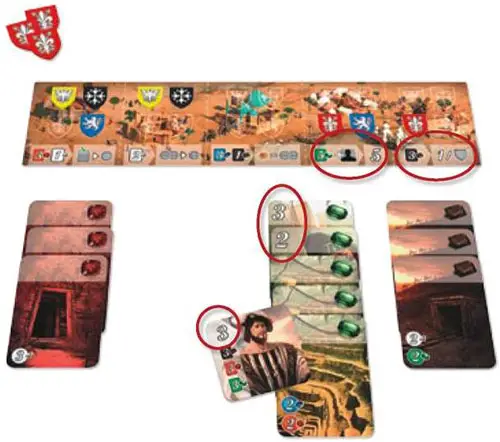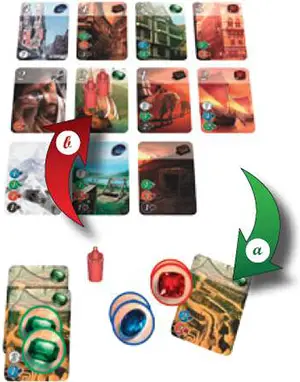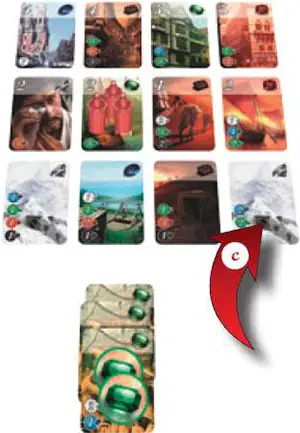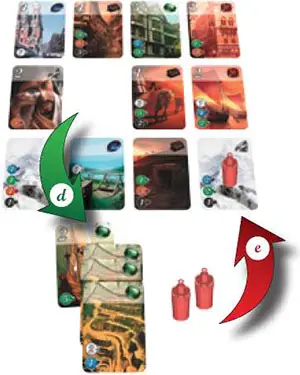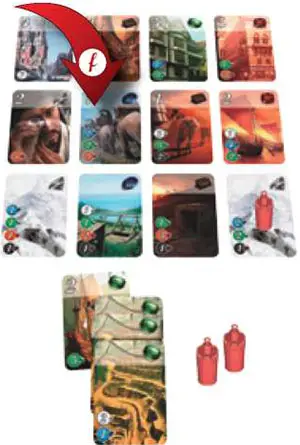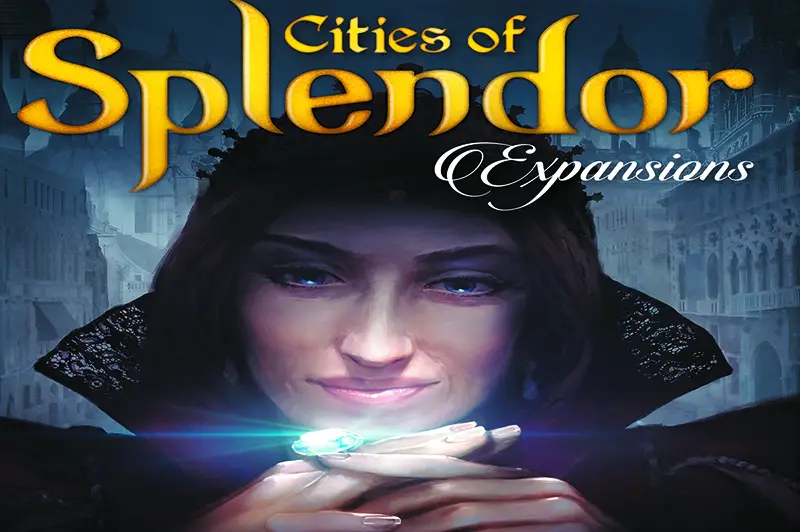
The Cities of Splendor shine throughout the world while wealth from the Orient offers new opportunities to all. These four expansions must be played singly.
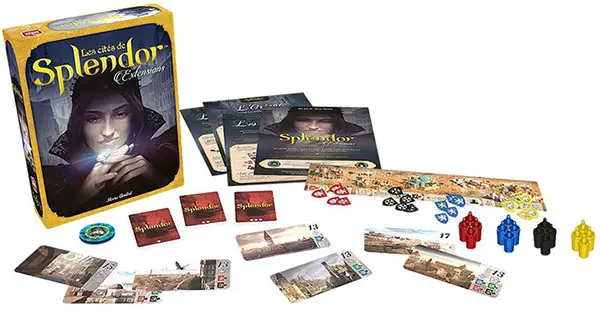
First Player Tile
Place this tile in front of the first player to remember that the player sitting on their right will be the last to play at the end of the game.
I. Cities
Bruges, Lyon, Lisbon, Seville, Venice, Florence, Pisa: each city wants to make a unique major scale jeweler's work and, to this end, spends lavishly. But will you be able to fulfill these extravagant demands?
We recommend that you play with this expansion first. It changes the game's victory condition and fosters competition among players.

Components
- 7 double-sided city tiles
Setup
Do not use the noble tiles.
Instead, shuffle the city tiles and always place 3 of them on either of their sides randomly (whatever the number of players).
The other tiles will not be used and are removed from the game.
Additional Rules
At the end of your turn, automatically take a city tile if you meet its requirements:
You have a number of prestige points at least equal to the value shown on the tile.
You have at least the quantity and type of bonuses shown on the tile (just like noble tiles).
Examples:
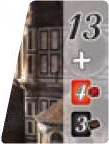
You must have at least 13 prestige points, 4 red bonuses, and 3 black bonuses.
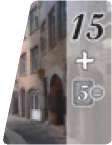
You must have at least 15 prestige points and 5 bonuses of the same type (e.g. 5 blue bonuses).
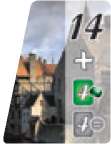
You must have at least 14 prestige points,4 green bonuses, and 4 bonuses in another single color (e.g. 4 black bonuses).
Note: If you meet the requirements of multiple city tiles, choose one (and only one) of them. Keep this tile until the end of the game.
End of the Game
When a player takes a city tile, complete the current round. At the end of that round, if only one player took a city tile, they win the game. If several players took a city tile, the player who has the highest number of prestige points among them is the winner.
II. Trading Posts
With the discovery of the sea routes to India, each guild establishes new trading posts. Who will adapt the best and the fastest to the worldwide new trade rules?
This expansion slightly shortens the game by granting you twisting powers. Keep a close eye on your opponents!
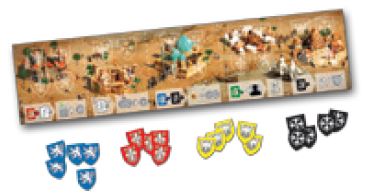
Components
- 1 "Route to the Orient" board
- 20 coats of arms (5 per color)
Setup
Place the board within players' easy reach a.
Each player takes 5 identical coats of arms b.
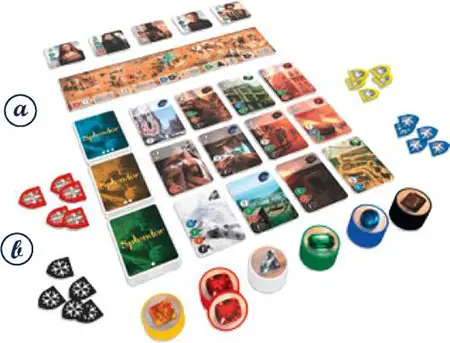
Additional Rules
At the end of your turn (immediately after the possible visit from a noble), if you meet the requirement c of a power d, place one of your coats of arms right above it, on its allocated space.
You benefit from this power until the end of the game.
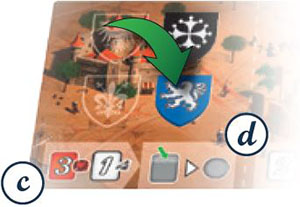
Description of the Powers
-
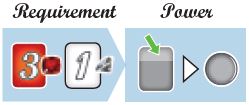
Requirement: You must have 3 red bonuses and 1 white bonus.
Power: After you purchase 1 development card, take 1 gem token.
Do not take a token on the turn during which you place your coat of arms. You must take the token before replacing the card. You may take one of the tokens you have just spent.
-

Requirement: You must have 2 white bonuses.
Power: When you take 2 gem tokens of the same color, take 1 gem token of another color. As usual, taking 2 gem tokens of the same color is only possible if there are at least 4 tokens available in that color.
-

Requirement: You must have 3 blue bonuses and 1 black bonus.
Power: Each of your gold tokens is worth 2 gem tokens of the same color.
You benefit from this power when you purchase a card. Each of your gold tokens still counts as 1 token against the limit of 10 tokens you can have at the end of your turn.
-

Requirement: You must have 5 green bonuses and 1 noble tile.
Power: 5 prestige points.
This can trigger the end of the game (just like the acquisition of a noble or the purchase of a card). You benefit from this power only once even if you have several nobles.
-

Requirement: You must have 3 black bonuses.
Power: 1 prestige point for each of your coats of arms on the board.
This can trigger the end of the game (just like the acquisition of a noble or the purchase of a card).
Example:
The red player has 15 prestige points:
- 3 for their noble,
- 5 for their cards,
- 5 for their second-to-last power,
- 2 for their last power (2 coats of arms placed on the last two spaces).
III. The Orient
The Orient is now opening its wealth to all and patrons are more and more attracted by its exoticism. In this fluctuating context, will you be able to transform your commercial empire?
The cards from this expansion place the nobles at the heart of new strategies: find the best way to get them faster, or to reserve them, or to make your cards profitable once they are gone.
Components

- 30 Orient development cards (10 per level)
Setup
Shuffle the 10 new level 1 cards (O), reveal 2 of them, and place them to the right of the base game cards. Then place the 8 remaining Orient cards in a deck to the right.
Proceed likewise with level 2 (OO) and level 3 (OOO) Orient cards on their respective rows.
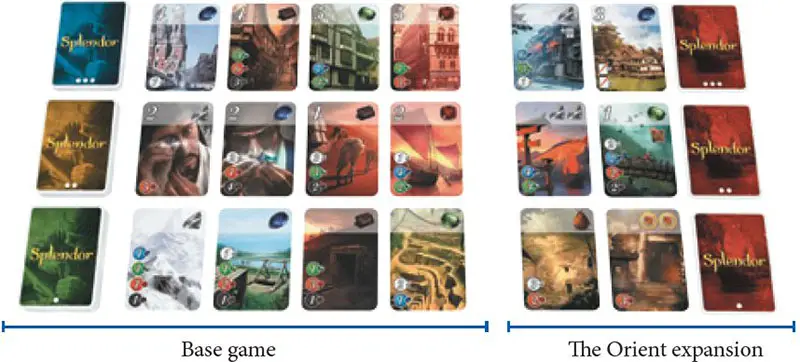
Additional Rules
Replace any purchased or reserved card with a card from its matching deck. Therefore, at all times during the game, there must be 4 base game cards and 2 Orient cards of each level face-up (unless the deck in question is depleted, in which case the empty spaces remain as is).
Description of The Orient Cards
Level 1 
-

This card is worth 2 gold tokens (do not draw them, they do not count against your limit of 10 tokens) and can be spent during a single purchase.
Each of these 2 gold tokens can replace any color. If you use only one, the second one is wasted. Once spent, this card is discarded (put it back in the box) and has no effect any longer.
-

Immediately and permanently pair this card with a card you previously acquired. This card is worth 1 bonus matching the bonus of the card it is paired with.
You cannot purchase this card if you do not have at least one card with a gem bonus.
Note: you must pair this card before replacing it.
Level 2 
-

Immediately and permanently pair this card with a card you previously acquired (see above), then take a face-up level 1
Ocard (base or Orient), and place it in front of you at no cost. -

This card is worth 2 bonuses of the indicated color. These bonuses count toward purchasing new cards, receiving visits from nobles and discarding (see level 3 cards).
-

Reserve a noble. Take the noble of your choice among those available and place it face-down in front of you: from now on, only you can be visited by this noble (if you meet the requirements).
You do not gain a gold token. There is no limit to the number of noble tiles you can reserve.
Level 3 
-
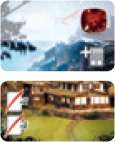
Take a face-up level 2 (OO) card (base or Orient) and place it in front of you at no cost.
To purchase one of these cards, you must discard 2 bonuses of the indicated color that you previously acquired (put them back in the box).
You cannot discard reserved cards. You must discard, as a priority, the cards bearing the J associated with this color, if you have any.
IV. Strongholds
While big cities establish trading colonies, the stakes and tensions emphasize. Each guild builds strongholds to protect its wealth from adverse ambitions and to facilitate its expansion.
This expansion adds more interaction and can slightly lengthen the game. Find the perfect balance between slowing down your opponents and speeding up your own acquisitions.
Components

- 12 strongholds (3 per color)
Setup
Each player takes 3 strongholds of the same color and places them in front of them.
Additional Rules
Each time you purchase a card (from your hand or from the table), you must choose one of the following two options (before replacing the purchased card):
-
Place or move one of YOUR strongholds on one of the face-up cards on the table, only if that card has not any other stronghold of another color. However, you can place a stronghold on a card on which one or two of your strongholds are already placed. OR
-
Remove another player's stronghold from a card on the table and give it back to its owner.
Powers of the Strongholds
Occupation power: A card on which a stronghold is placed can be purchased or reserved only by that stronghold's owner. In both instances, the player takes back their strongholds placed on that card.
Conquest power: While your 3 strongholds are on the same card, you can purchase this card after your action (whether you took gem tokens, or reserved or purchased 1 development card).
You must pay for the card, take back your strong- holds, then place or remove a stronghold before replacing the purchased card.
Specification: This purchase must be done before a noble visits you and before checking the number of tokens.
Example of a turn:
The red player purchases a new card
a.They place their third stronghold on the card with the other two
b.
The purchased card is replaced
c.
Then, the player chooses to benefit from the conquest power. They purchase the card
d, recover their 3 strongholds then decide to place oneeon the card revealed in 2.
The second purchased card is replaced
f.
Continue Reading
